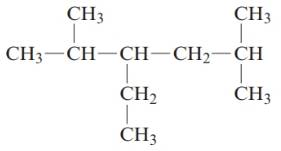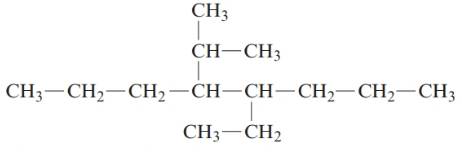
Introductory Chemistry: Foundation - Text (Looseleaf)
9th Edition
ISBN: 9781337399623
Author: ZUMDAHL
Publisher: Cengage
expand_more
expand_more
format_list_bulleted
Concept explainers
Textbook Question
Chapter 20, Problem 142CP
. Name each of the following
a.
b.
c.
Expert Solution & Answer
Trending nowThis is a popular solution!

Students have asked these similar questions
For which element is the 3d subshell higher in energy than that 4s subshell?
Group of answer choices
Zr
Ca
V
Ni
ii) Molecular ion peak
:the peak corresponding to the intact molecule (with a positive charge)
What would the base peak and Molecular ion peaks when isobutane is subjected
to Mass spectrometry? Draw the structures and write the molecular weights of
the fragments.
Circle most stable cation
a) tert-butyl cation
b) Isopropyl cation c) Ethyl cation. d) Methyl cation
6. What does a loss of 15 represent in Mass spectrum?
a fragment of the molecule with a mass of 15 atomic mass units has been lost during
the ionization Process
7. Write the isotopes and their % abundance of isotopes of
i) Cl
Choose a number and match the atomic number to your element on the periodic table. For your element, write each of these features on a side of your figure.
1. Element Name and symbol
2. Family and group
3. What is it used for?
4. Sketch the Valence electron orbital
5. What ions formed. What is it's block on the periodic table.
6. Common compounds
7. Atomic number
8. Mass number
9. Number of neutrons- (show calculations)
10. Sketch the spectral display of the element
11.Properties
12. Electron configuration
13. Submit a video of a 3-meter toss in slow-mo
Chapter 20 Solutions
Introductory Chemistry: Foundation - Text (Looseleaf)
Ch. 20.2 - Exercise 20.1 Give the molecular formulas for the...Ch. 20.4 - Exercise 20.2 Name the following molecules. a. b.Ch. 20.4 - Exercise 20.3 Write the structural formula for...Ch. 20.5 - Petroleum is a very valuable raw material for the...Ch. 20.7 - Exercise 20.4 Name the following molecules. a. b.Ch. 20.9 - Prob. 20.5SCCh. 20.11 - Prob. 20.6SCCh. 20.14 - Prob. 20.7SCCh. 20 - What is meant by the term “unsaturated...Ch. 20 - Prob. 2ALQ
Ch. 20 - Prob. 3ALQCh. 20 - How many different possible “tetramethylbenzenes”...Ch. 20 - For the general formula C6H14O, draw the...Ch. 20 - Prob. 6ALQCh. 20 - Prob. 1QAPCh. 20 - Your roommate, a chemistry major, claims to have...Ch. 20 - Prob. 3QAPCh. 20 - How many electron pairs are shared when a triple...Ch. 20 - Prob. 5QAPCh. 20 - Prob. 6QAPCh. 20 - Prob. 7QAPCh. 20 - Prob. 8QAPCh. 20 - Prob. 9QAPCh. 20 - . The chains in normal alkanes are not really...Ch. 20 - Prob. 11QAPCh. 20 - Prob. 12QAPCh. 20 - . Give the name of each of the following...Ch. 20 - Prob. 14QAPCh. 20 - . What are structural isomers? Which is the...Ch. 20 - Prob. 16QAPCh. 20 - Prob. 17QAPCh. 20 - Prob. 18QAPCh. 20 - Prob. 19QAPCh. 20 - Prob. 20QAPCh. 20 - . What is an alkyl group? How is a given alkyl...Ch. 20 - . When naming alkanes, find the longest continuous...Ch. 20 - Prob. 23QAPCh. 20 - . When naming alkanes, the alkyl groups are listed...Ch. 20 - . Give the systematic name for each of the...Ch. 20 - . Give the systematic name for each of the...Ch. 20 - Prob. 27QAPCh. 20 - Prob. 28QAPCh. 20 - Prob. 29QAPCh. 20 - Prob. 30QAPCh. 20 - . What is pyrolytic cracking, and why is the...Ch. 20 - Prob. 32QAPCh. 20 - . Explain why alkanes are relatively unreactive.Ch. 20 - Prob. 34QAPCh. 20 - . Indicate the missing molecule in each of the...Ch. 20 - Prob. 36QAPCh. 20 - Prob. 37QAPCh. 20 - Prob. 38QAPCh. 20 - Prob. 39QAPCh. 20 - Prob. 40QAPCh. 20 - Prob. 41QAPCh. 20 - Prob. 42QAPCh. 20 - Prob. 43QAPCh. 20 - Prob. 44QAPCh. 20 - Prob. 45QAPCh. 20 - Prob. 46QAPCh. 20 - Prob. 47QAPCh. 20 - Prob. 48QAPCh. 20 - Prob. 49QAPCh. 20 - . Benzene exhibits resonance Explain this...Ch. 20 - . How is a monosubstituted benzene named? Give the...Ch. 20 - Prob. 52QAPCh. 20 - Prob. 53QAPCh. 20 - . What do the prefixes ortho-, meta-, and para-...Ch. 20 - Prob. 55QAPCh. 20 - Prob. 56QAPCh. 20 - Prob. 57QAPCh. 20 - Prob. 58QAPCh. 20 - . What functional group characterizes an alcohol?...Ch. 20 - Prob. 60QAPCh. 20 - . Give the systematic name for each of the...Ch. 20 - . Is 1-pentanol a primary, secondary, or tertiary...Ch. 20 - . Why is methanol sometimes called wood alcohol?...Ch. 20 - Prob. 64QAPCh. 20 - . Write the equation for the synthesis of ethanol...Ch. 20 - . What is the simplest aromatic alcohol commonly...Ch. 20 - Prob. 67QAPCh. 20 - Prob. 68QAPCh. 20 - Prob. 69QAPCh. 20 - Prob. 70QAPCh. 20 - Prob. 71QAPCh. 20 - Prob. 72QAPCh. 20 - Prob. 73QAPCh. 20 - Prob. 74QAPCh. 20 - Prob. 75QAPCh. 20 - Prob. 76QAPCh. 20 - Prob. 77QAPCh. 20 - Prob. 78QAPCh. 20 - Prob. 79QAPCh. 20 - Prob. 80QAPCh. 20 - Prob. 81QAPCh. 20 - . Draw a structural formula for each of the...Ch. 20 - Prob. 83QAPCh. 20 - Prob. 84QAPCh. 20 - Prob. 85QAPCh. 20 - Prob. 86QAPCh. 20 - Prob. 87QAPCh. 20 - Prob. 88QAPCh. 20 - Prob. 89APCh. 20 - Prob. 90APCh. 20 - Prob. 91APCh. 20 - Prob. 92APCh. 20 - Prob. 93APCh. 20 - . The systematic names of all saturated...Ch. 20 - Prob. 95APCh. 20 - Prob. 96APCh. 20 - Prob. 97APCh. 20 - Prob. 98APCh. 20 - Prob. 99APCh. 20 - . With very reactive agents, such as the halogen...Ch. 20 - . Alkenes and alkynes are characterized by their...Ch. 20 - Prob. 102APCh. 20 - Prob. 103APCh. 20 - Prob. 104APCh. 20 - Prob. 105APCh. 20 - Prob. 106APCh. 20 - Prob. 107APCh. 20 - Prob. 108APCh. 20 - Prob. 109APCh. 20 - Prob. 110APCh. 20 - Prob. 111APCh. 20 - Prob. 112APCh. 20 - Prob. 113APCh. 20 - Prob. 114APCh. 20 - Prob. 115APCh. 20 - . Give the systematic name for each of the...Ch. 20 - Prob. 117APCh. 20 - Prob. 118APCh. 20 - Prob. 119APCh. 20 - Prob. 120APCh. 20 - Prob. 121APCh. 20 - Prob. 122APCh. 20 - Prob. 123APCh. 20 - Prob. 124APCh. 20 - Prob. 125APCh. 20 - Prob. 126APCh. 20 - Prob. 127APCh. 20 - Prob. 128APCh. 20 - Prob. 129APCh. 20 - Prob. 130APCh. 20 - Prob. 131APCh. 20 - . Write the formula for the missing reactant or...Ch. 20 - Prob. 133APCh. 20 - Prob. 134APCh. 20 - . Name each of the following aromatic or...Ch. 20 - Prob. 136APCh. 20 - Prob. 137APCh. 20 - Prob. 138APCh. 20 - Prob. 139APCh. 20 - Prob. 140APCh. 20 - Prob. 141APCh. 20 - . Name each of the following alkanes....Ch. 20 - Prob. 143CPCh. 20 - Prob. 144CPCh. 20 - Prob. 145CPCh. 20 - Prob. 146CPCh. 20 - Prob. 147CP
Additional Science Textbook Solutions
Find more solutions based on key concepts
45. Calculate the mass of nitrogen dissolved at room temperature in an 80.0-L home aquarium. Assume a total pre...
Chemistry: Structure and Properties (2nd Edition)
Label each statement about the polynucleotide ATGGCG as true or false. The polynucleotide has six nucleotides. ...
General, Organic, and Biological Chemistry - 4th edition
1. Genetics affects many aspects of our lives. Identify three ways genetics affects your life or the life of a ...
Genetic Analysis: An Integrated Approach (3rd Edition)
Some people consider Pasteur or Koch to be the Father of Microbiology, rather than Leeuwenhoek. Why might they ...
Microbiology with Diseases by Body System (5th Edition)
Knowledge Booster
Learn more about
Need a deep-dive on the concept behind this application? Look no further. Learn more about this topic, chemistry and related others by exploring similar questions and additional content below.Similar questions
- [In this question, there are multiple answers to type in a "fill-in-the-blank" fashion - in each case, type in a whole number.] Consider using Slater's Rules to calculate the shielding factor (S) for the last electron in silicon (Si). There will be electrons with a 0.35 S-multiplier, electrons with a 0.85 S-multiplier, and electrons with a 1.00 S-multiplier.arrow_forwardProvide the unknown for the given data.arrow_forwardDraw the Lewis structures of two methanol (CH3OH) molecules and depict hydrogenbonding between them with dashed lines. Show all lone pairs. Provide a thorough analysis to apply concept idea into other problems.arrow_forward
- Steps and explanation please.arrow_forwardHow could you distinguish between each pair of compounds below using IR? For each pair citeone bond and it’s frequency that you could use to distinguish between them. Please provide thorough analysis to apply into further problems.arrow_forwardSteps and explanation please.arrow_forward
- Provide the unknown for the given dataarrow_forwardProvide the unknown for the given data.arrow_forwardElectron Arrangement A. Fill in the following chart relating to levels, sublevels and orbitals. Levels (n) 1 Sublevels # of Orbitals per sublevel 2 3 4 # of Electrons per sublevel Total Electrons per level Complete: B. Answer the following questions related to levels, sublevels, orbitals and electrons. 1. How many sublevels are in energy level 2? 2. How many orbitals are in a 4f sublevel? 3. How many electrons can level 3 hold? 4. How many orbitals are in level 4? 5. How many electrons can sublevel 2p hold? 11arrow_forward
arrow_back_ios
SEE MORE QUESTIONS
arrow_forward_ios
Recommended textbooks for you
 World of Chemistry, 3rd editionChemistryISBN:9781133109655Author:Steven S. Zumdahl, Susan L. Zumdahl, Donald J. DeCostePublisher:Brooks / Cole / Cengage Learning
World of Chemistry, 3rd editionChemistryISBN:9781133109655Author:Steven S. Zumdahl, Susan L. Zumdahl, Donald J. DeCostePublisher:Brooks / Cole / Cengage Learning Chemistry for Today: General, Organic, and Bioche...ChemistryISBN:9781305960060Author:Spencer L. Seager, Michael R. Slabaugh, Maren S. HansenPublisher:Cengage Learning
Chemistry for Today: General, Organic, and Bioche...ChemistryISBN:9781305960060Author:Spencer L. Seager, Michael R. Slabaugh, Maren S. HansenPublisher:Cengage Learning- Chemistry: Matter and ChangeChemistryISBN:9780078746376Author:Dinah Zike, Laurel Dingrando, Nicholas Hainen, Cheryl WistromPublisher:Glencoe/McGraw-Hill School Pub Co
 Chemistry: Principles and PracticeChemistryISBN:9780534420123Author:Daniel L. Reger, Scott R. Goode, David W. Ball, Edward MercerPublisher:Cengage Learning
Chemistry: Principles and PracticeChemistryISBN:9780534420123Author:Daniel L. Reger, Scott R. Goode, David W. Ball, Edward MercerPublisher:Cengage Learning Introductory Chemistry: An Active Learning Approa...ChemistryISBN:9781305079250Author:Mark S. Cracolice, Ed PetersPublisher:Cengage Learning
Introductory Chemistry: An Active Learning Approa...ChemistryISBN:9781305079250Author:Mark S. Cracolice, Ed PetersPublisher:Cengage Learning

World of Chemistry, 3rd edition
Chemistry
ISBN:9781133109655
Author:Steven S. Zumdahl, Susan L. Zumdahl, Donald J. DeCoste
Publisher:Brooks / Cole / Cengage Learning


Chemistry for Today: General, Organic, and Bioche...
Chemistry
ISBN:9781305960060
Author:Spencer L. Seager, Michael R. Slabaugh, Maren S. Hansen
Publisher:Cengage Learning

Chemistry: Matter and Change
Chemistry
ISBN:9780078746376
Author:Dinah Zike, Laurel Dingrando, Nicholas Hainen, Cheryl Wistrom
Publisher:Glencoe/McGraw-Hill School Pub Co

Chemistry: Principles and Practice
Chemistry
ISBN:9780534420123
Author:Daniel L. Reger, Scott R. Goode, David W. Ball, Edward Mercer
Publisher:Cengage Learning

Introductory Chemistry: An Active Learning Approa...
Chemistry
ISBN:9781305079250
Author:Mark S. Cracolice, Ed Peters
Publisher:Cengage Learning
Chapter 4 Alkanes and Cycloalkanes Lesson 2; Author: Linda Hanson;https://www.youtube.com/watch?v=AL_CM_Btef4;License: Standard YouTube License, CC-BY
Chapter 4 Alkanes and Cycloalkanes Lesson 1; Author: Linda Hanson;https://www.youtube.com/watch?v=PPIa6EHJMJw;License: Standard Youtube License